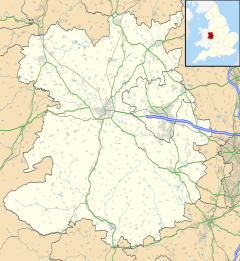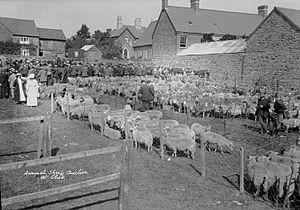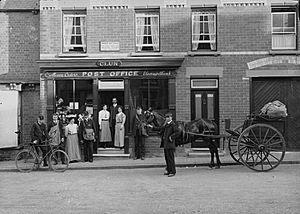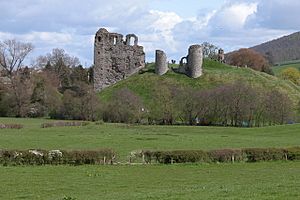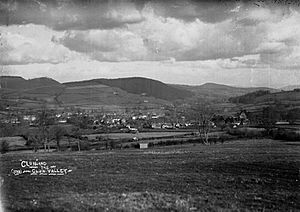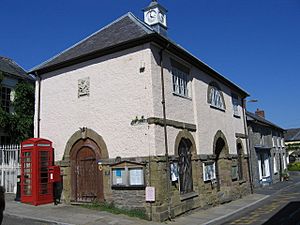Clun facts for kids
Quick facts for kids Clun |
|
|---|---|
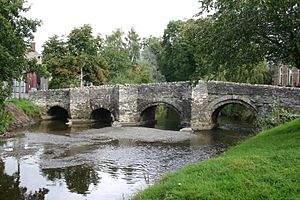 Clun Bridge over the River Clun |
|
| Population | 680 (2011 Census) |
| OS grid reference | SO302808 |
| Civil parish |
|
| Unitary authority |
|
| Ceremonial county | |
| Region | |
| Country | England |
| Sovereign state | United Kingdom |
| Post town | CRAVEN ARMS |
| Postcode district | SY7 |
| Dialling code | 01588 |
| Police | West Mercia |
| Fire | Shropshire |
| Ambulance | West Midlands |
| EU Parliament | West Midlands |
| UK Parliament |
|
Clun (pronounced "klun") is a small, peaceful town in south west Shropshire, England. It's located in the beautiful Shropshire Hills Area of Outstanding Natural Beauty. In 2011, about 680 people lived here. Experts say Clun is one of the most "tranquil" (calm and quiet) places in England. The town gets its name from the River Clun, which flows through it.
Contents
Clun's History
How Clun Got Its Name
Clun's name comes from the river it sits beside. The name "Clun" comes from an old Welsh word, Colunwy. This word is also the root for other rivers and towns in England, like the two rivers named Colne.
Early Days and Growth
Clun started around an Anglo-Saxon church in the late 600s AD. But people lived in the area much earlier, about 5,000 years ago, during the Neolithic period (New Stone Age). Clun was an important stop on old "drove roads." These were paths where farmers moved large groups of animals, like sheep and cattle, from Wales to markets in central England and London.
Norman Conquest and Clun Castle
After the Norman Conquest in 1066, King William I took control of England. He gave a lot of land, including Clun, to a powerful Norman lord named Roger de Montgomery. Roger then gave Clun to Picot de Say. This area became known as the Barony of Clun. The de Say family then built Clun Castle.
Clun Bridge and Its Saying
The old Clun Bridge was built in the 1300s. It's a "pack horse bridge," meaning it was made for horses carrying goods. This bridge connects the older Saxon part of Clun to the newer Norman part. There's a local saying about it: "whoever crosses Clun Bridge comes back sharper than he went." This means you learn something new or become wiser after visiting Clun.
The "Malevolent Mill"
North of town is Clun Mill, sometimes called the "malevolent mill." This is because some strange things happened there, with people disappearing or dying after buying it. The mill stopped being used around 1920. In 1932, it became a youth hostel, a place for young travelers to stay.
Clun's Geography
Rivers and Landscape
The River Clun flows through the town from west to east. The area around Clun, known as the Clun Valley, is mostly farmland. There are also some woodlands. Another river, the River Unk, joins the Clun just west of the town.
Roads and Nearby Places
Two main roads, the A488 and B4368, meet in Clun. Nearby towns in Shropshire include Craven Arms, Bishop's Castle, and Ludlow. The Welsh town of Knighton is about 7 miles (11 km) south. Famous walking paths like Offa's Dyke Path, Jack Mytton Way, and Shropshire Way pass through or near Clun. Offa's Dyke is an ancient earthwork that marked a border.
Town's Elevation and Crossings
The main part of Clun, on the north side of the River Clun, is about 185 meters (607 feet) above sea level. The oldest part, near St George's Church, is a bit higher. The Clun Bridge is at 181 meters (594 feet) above sea level. Besides the bridge, there's a "ford" (a shallow place to cross a river) downstream. There's also a footbridge near the main car park that leads to the castle.
Clun's Population
Clun is the smallest town in Shropshire. In 2011, 680 people lived in the town itself. This is a population size usually found in a village today. It's thought that Clun had more people centuries ago when the wool trade was very important. Clun is also the only town in Shropshire that has never had a railway line or station.
Things to See and Do in Clun
Clun has several interesting places to visit:
- The old Clun Castle: It's a Norman castle, but now it's a ruin. The castle grounds are used for the May fair.
- The Clun Bridge: This bridge from the 1400s is still mostly original stone. It's a road bridge used by all vehicles today.
- Trinity Hospital: These are almshouses (homes for poor people) built in 1614.
- Clun Town Hall Museum: You can find a museum in the Clun Town Hall.
St George's Church
The main church in Clun is St George's Church. It's on a steep hill south of Clun Bridge. Parts of the church have Norman columns. Most of the church was rebuilt in 1877 by a Victorian architect named G. E. Street.
Walking in Clun
Clun is a great place for walkers. You can start here to explore the Shropshire Way, the Jack Mytton Way, or other local walking paths. There's a car park for walkers at the Memorial Hall.
Clun's Facilities
Shops and Services
Clun's main streets are Enfield Street, The Square, High Street, Ford Street, Bridge Street, and Church Street. You'll find a few shops, including a hair salon and a convenience store. There are also two cafes, one right on the bridge. "Caractacus" in The Square sells gifts, and "Craft Creations" on Ford Street sells handmade items. The post office is now inside the convenience store. There's also a museum in The Square.
Pubs and Hotels
Clun has two pubs: the Sun Inn and the White Horse Inn. The Buffalo Head Hotel has been closed since about 2004.
Schools and Community Centers
The town has a primary school called St George's. It's known for its good nursery and excellent education. The school holds events like nativity plays and festivals at the nearby church.
There are two community centers:
- The Memorial Hall: This hall is dedicated to local people who died in the World Wars. It hosts community events like sports days and film showings. You can also rent it for weddings.
- The Hightown Community Room: This is another community space.
There's also a Youth Hostel at Clun Mill, just north of the town.
Parking
There's a short-stay car park near Clun Bridge with public toilets. Walkers and tourists are asked to use the larger Memorial Hall car park to avoid crowding.
Clun's Festivals
Clun hosts several fun festivals throughout the year:
- Green Man Festival: This festival happens over three days during the first May bank holiday. On the Monday, the Green Man battles the spirit of winter at Clun Bridge. A May fair is held at Clun Castle with a May Queen.
- Clun Open Gardens: On the last weekend in June, about 20 private gardens open to the public. You can buy cream teas, plants, books, and garden tools. St George's Church has flower arrangements and music.
- Clun Carnival and Show: This takes place on the first Saturday in August. There's a procession through the town and a fete (a type of fair) at the playing fields. People show off their vegetables, cakes, and flower arrangements. There are also stalls, a bouncy castle, and a tea tent.
- Clun Valley Beer Festival: This festival happens on the first weekend in October. Six pubs in the Clun Valley take part.
Media in Clun
For television, Clun gets news from BBC Midlands Today and ITV News Central, both from Birmingham. Radio stations include BBC Radio Shropshire (104.1 FM), Sunshine Radio (105.9 FM), Greatest Hits Radio Black Country & Shropshire (106.5 FM), and Hits Radio Black Country & Shropshire (103.1 FM). The local newspaper is the Shropshire Star.
Other Uses of the Name Clun
The name "Clun" is sometimes used for the far southwest part of Shropshire county. Shropshire Council has an "electoral division" (an area for voting) called Clun. This area covers Clun and the villages around it. The term "Clun Valley" is also used for the villages and communities along the River Clun, like Anchor and Aston on Clun.
Famous People Connected to Clun
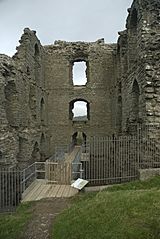
Several notable people have connections to Clun:
- Robert de Say (11th Century): A Norman knight who started building Clun Castle.
- John Burrough (1873 in Clun – 1922): A cricketer who played for Cambridge University.
- William Burrough (1875 in Clun – 1939): Another cricketer who played for Somerset.
- Bruce Bairnsfather (1887–1959): A famous cartoonist who lived in Clun during WWII. He created the "Old Bill" cartoons.
- John Osborne (1929–1994): A famous playwright who wrote Look Back in Anger. He lived nearby in Clunton.
- Guy N. Smith (1939–2020): An English writer, mainly of horror fiction, who lived near Clun later in his life.
Clun in Books and Culture
Clun has appeared in several famous works:
- The writer Sir Walter Scott is said to have stayed at The Buffalo Inn. He supposedly based the castle in his novel The Betrothed (published 1825) on Clun Castle.
- In A Shropshire Lad, a book of poems by A. E. Housman, there's a famous verse: "Clunton and Clunbury,/ Clungunford and Clun,/ Are the quietest places/ Under the sun."
- E. M. Forster visited Clun, and it later appeared as "Oniton" in his novel Howards End (1910).
- Malcolm Saville wrote a series of mystery books for children (The Lone Pine Club) that were set in Clun or nearby places.
 |
Cefn Einion, Mainstone | Colebatch Bishop's Castle |
Lydbury North Shrewsbury (county town) |
 |
| Whitcott Keysett, Newcastle, Bettws-y-crwyn, Anchor | Clunton, Clunbury, Purslow, Aston on Clun Craven Arms |
|||
| Llanfair Waterdine, Knucklas | New Invention Knighton |
Bucknell, Bedstone, Leintwardine |
Images for kids
-
Clun Bridge over the River Clun
See also
 In Spanish: Clun para niños
In Spanish: Clun para niños


